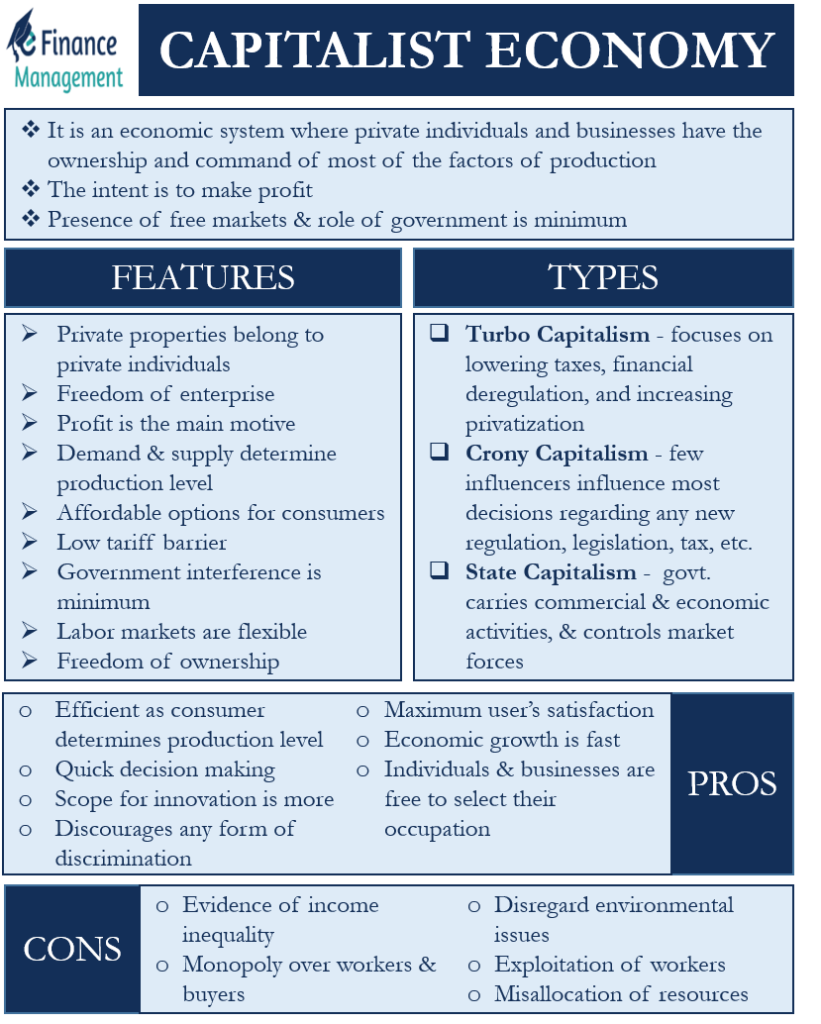What is a Capitalist Economy?
A Capitalist Economy or Capitalism is an economic system where private individuals and businesses have the ownership and command of most of the factors of production. Moreover, in this economic system, the production of goods and services depends on market demand and supply.
The primary characteristic of this economic system is the intent to make a profit. Another important characteristic of this system is the presence of free markets. The role of government in this economic system is minimum.
In this system, those with surplus resources invest the capital, and they also own the factors of production. Such people or businesses earn a profit, and those involved in the production process get salaries or wages on the basis of the work they do.
18th century England can be referred to as the origin point of capitalism. At the time, England was witnessing an industrial revolution. The U.S.A., U.K., and Germany are some classic examples of this economic system.
Features of Capitalist Economy
Following are the features of the capitalist economy:
- Private properties in an economy belong to private individuals or businesses. These properties could be machines, equipment, factories, etc.
- Freedom of enterprise is another crucial feature of this system. It means that individuals and businesses (both consumers and producers) are free to make economic decisions.
- Earning profit is one of the main driving forces in this economic system. It means that the companies sell products and services to maximize profit.
- Demand and supply in the market determine the production level in this economic system. This, in turn, helps to set the price of the products and services without any government intervention. Such demand and supply forces are referred to as the ‘invisible hand’ that controls the working of the capitalist economy.
- Usually, there is cut-throat competition in the market as many people or business offers the same goods or services. This results in more, better, and more affordable options for consumers.
- Consumer demand controls the market and the level of production of businesses. Moreover, the consumer is free to decide on the goods that they want to buy.
- A low tariff barrier is another important feature of this system. This helps to promote international trade.
- Government interference in this economic system is very minimum. So, buyers and businesses are free to make decisions regarding the goods and services they want to buy or produce.
- Labor markets are flexible in regard to the hiring and firing of the workforce.
- There is freedom of ownership in this economic system. It implies that individuals and businesses can own any amount of wealth and use it as per their will. This wealth gets transferred to their successor after their death.
Types of Capitalist Economy
Different types of capitalism exist across nations, and some of the most popular ones are:
Turbo Capitalism
Edward Lattwak was the first to use this term in 1989. In this type of capitalism, there aren’t any regulatory measures or authority. More features of this capitalist system are that it focuses on lowering taxes, financial deregulation, and increasing privatization. Another name for this type of capitalism is unrestrained capitalism or free-market capitalism. One major drawback of this system is that it lacks measures to sustain its growth.
Crony Capitalism
This system works like a normal capitalist system. But few influencers influence most decisions regarding any new regulation, legislation, tax measure, government grants, subsidy, permit, etc. These influencers could be big businesses, trade unions, and more. Such a system is popular in developing countries. This system, however, could lead to corruption and bribery.
State Capitalism
In this, it is the government that carries out commercial and economic activities, as well as controls the market forces. In a way, it is a type of market, i.e., monopolistic, that the government controls. Singapore is an excellent example of this economic system. In Singapore, it is the government that owns and manages important corporations, as well as comes up with business-friendly legislation.

Advantages and Disadvantages of Capitalist Economy
Following are the advantages of this economic system:
- This economic system is more efficient as consumer demand determines the production level.
- Decision-making is quick as there is minimum government or bureaucratic interference.
- The scope for innovation is more as earning profit is the primary objective under this capitalist system. Thus, businesses strive to come up with innovative ways to beat the competition.
- This economic system discourages any form of discrimination. It ensures trade without any barriers.
- Since production is in accordance with the user’s taste and preferences, it results in maximum satisfaction.
- Individuals and businesses are free to select their occupation and enterprise.
- Owing to the competition, buyers get goods and services at fewer prices.
- Entrepreneurs are encouraged to take on more risks to offer better goods and services to consumers.
- Economic growth is fast and high as businesses invest in projects that are profitable.
- Businesses efficiently use the factors of production to maximize their profits.
Below are the disadvantages of this economic system:
- There is evidence that such an economic system results in income inequality. Rich get richer, and poor get poorer.
- Businesses can attain a monopoly over workers and buyers.
- The profit motive in this system could push businesses to disregard environmental issues.
- Such an economic system may result in the exploitation of workers.
- There could be a misallocation of resources. Businesses may allot more resources to produce luxury goods, leaving fewer resources for the necessities.
Final Words
The purest form of capitalism (or laissez-faire capitalism) is where there are no checks or restrictions on businesses and individuals with regard to financial decisions. In reality, such capitalism doesn’t exist. Instead, most nations follow a mixed capitalist system. Under this system, the government does exercise some degree of control over the business, as well as own and manage some industries.

